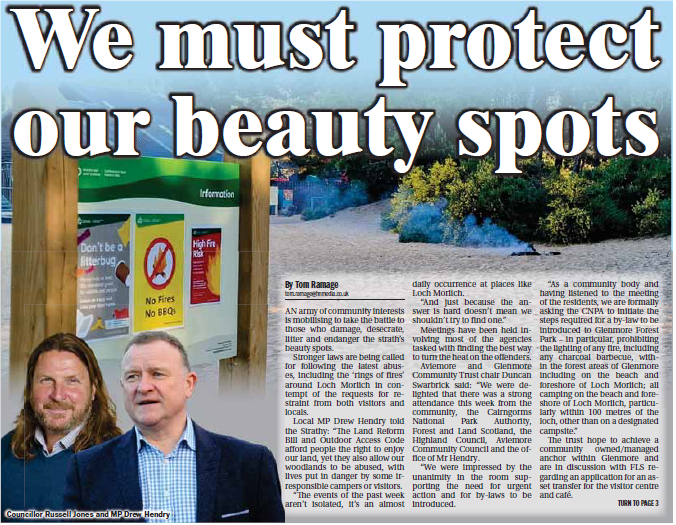
A significant row has developed in Glenmore, the most popular place for visitors in the Cairngorms, and various interests are now trying to stampede the Cairngorms National Park Authority (CNPA) into initiating measures to ban camping there. This post argues that primary responsibility for the problems in Glenmore lie with Forest and Land Scotland and explains why camping byelaws are not the answer.
Fires and camping in Glenmore

It is beyond doubt that some people have been lighting fires around Loch Morlich, at the heart of the Caledonian Pine Forest in Glen More, even during the very dry spell and despite the very prominent advice about the risks.

Those people besides being very stupid should, as I will explain later, almost certainly have been charged with breaking the law. It is, however, important to note that while some or all of these fires may have been associated with camping, that is not necessarily the case and they are two distinct issues. All over Scotland both day visitors and local residents also light fires, for example to have a barbecue or to keep the midges away.
To the extent, however, that the recent fire risks in Glenmore have been associated with campers, then Forest and Land Scotland should be held responsible. Last year, having bought back the lease for the Glenmore campsite from the Camping and Caravanning Club, who had kept it shut after lockdown ended, they decided to outsource it again (see here). They then excluded the Aviemore and Glenmore Community Trust (AGCT) from taking over the management of the site and awarded a lease to Twinflower, a company from Glasgow that runs a successful nightclub business (see here). As I commented at the time this was not in the public interest and “Just what the local area is getting is unclear”.
The charges for the Glenmore campsite, which were bad enough under the Camping and Caravanning Club’s period of mismanagement, are now (see here) extortionate:

With people struggling financially, faced with a charge of £26.65 for a night in a tent for two, it should be no surprise that significant numbers are choosing to do so by the road. With “High Season” charges of £36.40 coming into effect at the end of last week, the displacement of campers onto the shores of Loch Morlich is only going to get worse over the rest of the summer.
Local residents and visitors alike are now reaping the fact that Forest and Land Scotland ignored advice from the Cairngorms National Park Authority (CNPA) that more affordable camping provision was needed in Glenmore (something that the Aviemore and Glenmore Community Trust included in their bid for the site). The real question therefore is why aren’t local interests now calling on FLS’ senior management team, who have put their financial interests before the public interest, to be held to account by Scottish Ministers and forced to renegotiate the rental levels in their lease with Twinflower which appears to have helped drive up the prices at the campsite?
The whole debacle is a repeat of what happened in Loch Lomond and the Trossachs where the National Park Authority allowed large number of campsites to go “upmarket”, leaving nowhere affordable for campers to stay. The consequences were predictable (more litter and human waste around the edges of lochs) but the LLTNPA then used them to justify bringing in camping byelaws.
The situation on the east shore of Loch Lomond is now about to get worse again thanks also to FLS’s failed management. In the Spring, months after it had awarded the lease for the Glenmore campsite, FLS also awarded Twinflower the lease for the Sallochy Campsite on the east shore of Loch Lomond. Charges there (see here) have similarly increased (also £14 a night for a single backpacker). The inevitable consequence will be that more people walking the West Highland Way who cannot afford those prices will be driven into breaking the camping byelaws there.
The wider problems with camping and fires in the Cairngorms

While it is not clear if the fires at the Speyside Beach Meadows by Kingussie referred to here were associated with campers, this illustrates part of the wider problem: there is an almost total absence of affordable camping provision on Speyside. If the CNPA was unwise enough to initiate a process of introducing camping byelaws at Loch Morlich, it would simply displace the issues elsewhere leaving other communities to pick up the pieces. (The consequences can be felt far away as the handful of residents in Glen Etive found after the introduction of the camping byelaws in the Loch Lomond and Trossachs).
While the National Park Partnership Plan (NPPP) approved last year gave no specific consideration to the needs of campers it did contain a target:
“Develop a Strategic Tourism Infrastructure Plan to provide high-quality infrastructure at key visitor hotspots and for key sectors (eg camping and motorhomes).”
Unfortunately the date for delivering that plan is 2027, far too late to be of any use in addressing the current issues.
The second problem is that the CNPA appears to have no plans at present to provide any infrastructure that would enable people, whether campers or not, to enjoy fires safely and force organisations like FLS to provide appropriate facilities. Two weeks ago I spent a night at the campsite in Braemar owned by the Invercauld Estate (£20 for two people, a tent and a car for the night with hot showers included). We were told on arrival that we couldn’t light a fire (not that we ever do so) because “there are no fires in the Cairngorms”. The very nice wardens didn’t seem to appreciate the irony of this message:
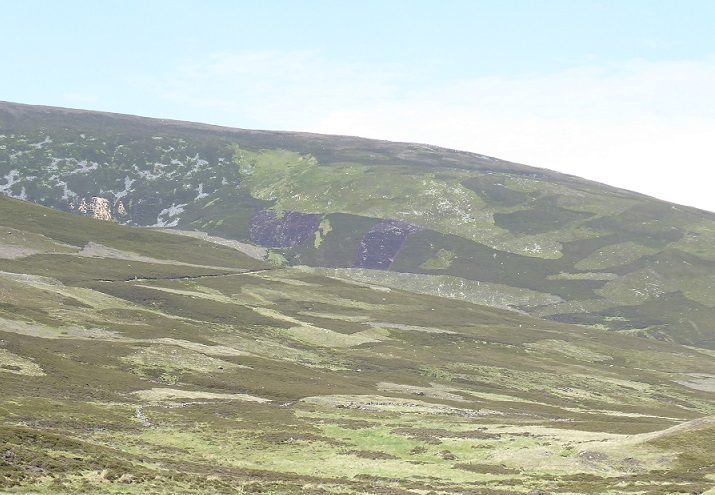
The CNPA also sometimes gives the impression it would prefer it if visitors lit no fires while continuing to allow widespread muirburn to continue in the National Park. It is worth noting in respect of the current calls that the CNPA not only has the power to propose byelaws to control recreational activities, like camping, but also for conservation purposes and could propose a complete ban on muirburn if it so wished. To proceed with one without the other would be totally hypocritical.
Set that aside, if the CNPA wants to manage fire risk more effectively they need to encourage provision for campfires and barbecues and there is no better place for this than in supervised areas like the campsites in Braemar or Glenmore. (At Loch Morlich there is an extensive source of firewood nearby in the McAlpine plantation (see here) which has little conservation value – its lodgepole pine – and with a bit of imagination FLS could have made available to the campsite, drawing in those who are determined to light fires rather than displacing them).
Introducing facilities in appropriate places to enable visitors to enjoy fires and barbecues safely would not prevent the CNPA and other land-managers asking people not to use those facilities in very dry periods. Most people would understand and respect that even though, as a reader reminded me this week, in very dry countries like Australia visitor hotspots are almost invariably provided with barbecue facilities which people are allowed to use in most conditions.
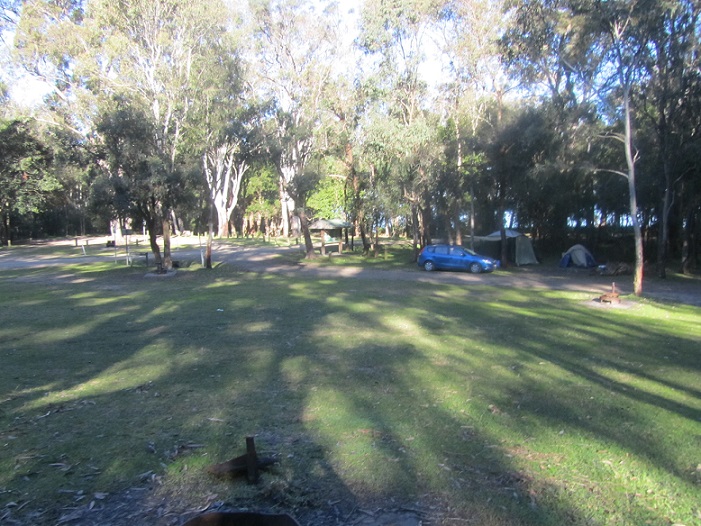
In considering how to manage the risks of fire in places like Glenmore, the CNPA should learn from other countries and put appropriate infrastructure in place.
The law on fires, access rights and the Scottish Outdoor Access Code
Those advocating a camping ban to address the fire risks in Glenmore appear to have forgotten one simple fact. It has long been an offence to light dangerous fires. The law is summarised in the Scottish Outdoor Access Code (SOC):
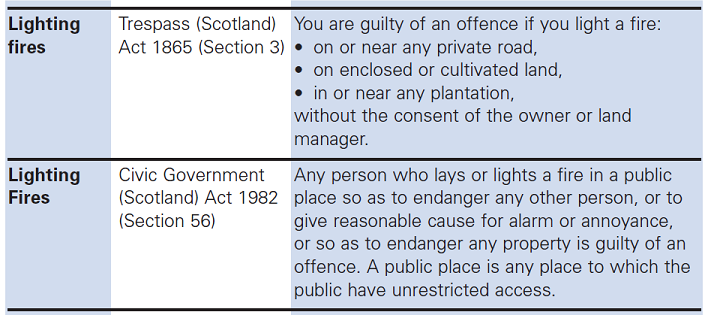
It is not clear whether anyone called the police in response to the fires around the shores of Loch Morlich and, if so, how they responded but the fire risks should and could have been dealt with under the existing law (just like other offences such as littering). Instead of advocating for camping byelaws, which would take several years to introduce even if the process was successful, local residents and the bodies which represent them like the AGCT should be calling for the existing law to be enforced.
Unfortunately, the intervention from local MP Drew Hendry, who appears to have little understanding of access rights or the role of the SOAC, has helped obscure this issue. If quoted correctly, he was completely wrong to state that “access rights allow our woodlands to be abused, with lives put at risk by some irresponsible campers and visitors”. Prior to the Land Reform Act in 2003 people had the freedom to access most land Scotland and on most public land, such as that owned by the then Forestry Commission in Glenmore, access was officially recognised. The legal position regarding fires was the same then as it is now – the law was not changed by the creation of access rights.
That was not an accident. The whole point of the Land Reform Act is that it was built on the recognition that the existing law regarding what is and is not irresponsible behaviour was fit for the purpose and sufficient to deal with problems such as those now taking place in Glenmore. The issue, to which Mr Hendry should give his attention, is not “hard” as he claimed in the Strathy but rather why those existing laws are not being enforced in Glenmore. What he should be asking is how many people in the last few weeks have been charged in Glenmore under section 56 of the Civic Government Act for endangering other people and property or for giving cause for alarm and annoyance?
The mistake that has been happening (which has confused people from MPs downwards) is that some people have been wanting SOAC to substitute for the criminal law. It was never intended for that purpose but rather to set out the types of behaviour that can result in a person losing their access rights (the courts if asked to decide whether someone has access rights will take SOAC into account) and to act as an educational tool to promote responsible behaviour.
This is why SOAC explicitly refers to other laws, such as that on fires (see extract above), while at the same time providing advice:
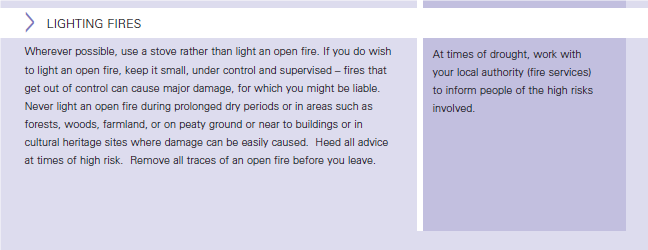
The messages being put out by the CNPA during the very dry spell have been completely compatible with SOAC and eminently sensible. But when an irresponsible minority ignore those messages the answer is not to change SOAC or access rights but our public authorities and MPs like Mr Hendry to do all they can to ensure the law is actually enforced.
Creating byelaws won’t solve the enforcement problem, it will simply help shift responsibility away from the police. But even more important than enforcement is to provide people with the infrastructure to reduce the number of problems that occur in the first place. That is why the senior management team at FLS bear primary responsibility for what has been happening in Glen More and why Scottish Ministers now need to hold them to account.

2 Comments on “Forest and Land Scotland, the fires in Glen More and access rights”